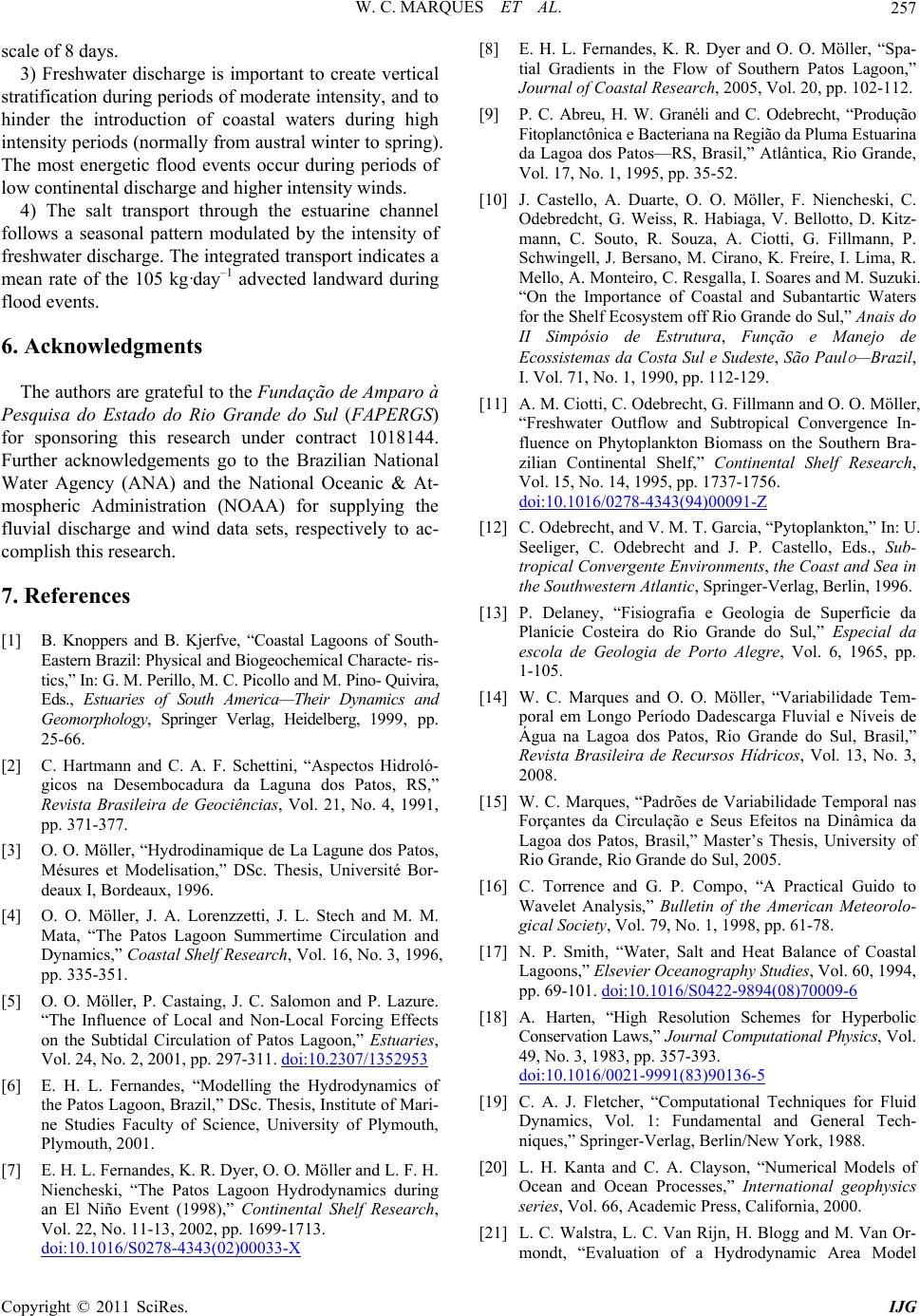
W. C. MARQUES ET AL.257
scale of 8 days.
3) Freshwater discharge is important to create vertical
stratification during periods of moderate intensity, and to
hinder the introduction of coastal waters during high
intensity periods (normally from austral winter to spring).
The most energetic flood events occur during periods of
low continental d ischarge and higher intens ity winds.
4) The salt transport through the estuarine channel
follows a seasonal pattern modulated by the intensity of
freshwater discharge. The integrated transport indicates a
mean rate of the 105 kg·day–1 advected landward during
flood events.
6. Acknowledgments
The authors are grateful to the Fundação de Amparo à
Pesquisa do Estado do Rio Grande do Sul (FAPERGS)
for sponsoring this research under contract 1018144.
Further acknowledgements go to the Brazilian National
Water Agency (ANA) and the National Oceanic & At-
mospheric Administration (NOAA) for supplying the
fluvial discharge and wind data sets, respectively to ac-
complish this research.
7. References
[1] B. Knoppers and B. Kjerfve, “Coastal Lagoons of South-
Eastern Brazil: Physical and Biogeochemical Characte- ris-
tics,” In: G. M. Perillo, M. C. Picollo and M. Pino- Quivira,
Eds., Estuaries of South America—Their Dynamics and
Geomorphology, Springer Verlag, Heidelberg, 1999, pp.
25-66.
[2] C. Hartmann and C. A. F. Schettini, “Aspectos Hidroló-
gicos na Desembocadura da Laguna dos Patos, RS,”
Revista Brasileira de Geociências, Vol. 21, No. 4, 1991,
pp. 371-377.
[3] O. O. Möller, “Hydrodinamique de La Lagune dos Patos,
Mésures et Modelisation,” DSc. Thesis, Université Bor-
deaux I, Bordeaux, 1996.
[4] O. O. Möller, J. A. Lorenzzetti, J. L. Stech and M. M.
Mata, “The Patos Lagoon Summertime Circulation and
Dynamics,” Coastal Shelf Research, Vol. 16, No. 3, 1996,
pp. 335-351.
[5] O. O. Möller, P. Castaing, J. C. Salomon and P. Lazure.
“The Influence of Local and Non-Local Forcing Effects
on the Subtidal Circulation of Patos Lagoon,” Estuaries,
Vol. 24, No. 2, 2001, pp. 297-311. doi:10.2307/1352953
[6] E. H. L. Fernandes, “Modelling the Hydrodynamics of
the Patos Lagoon, Brazil,” DSc. Thesis, Institute of Mari-
ne Studies Faculty of Science, University of Plymouth,
Plymouth, 2001.
[7] E. H. L. Fernandes, K. R. Dyer, O. O. Möller and L. F. H.
Niencheski, “The Patos Lagoon Hydrodynamics during
an El Niño Event (1998),” Continental Shelf Research,
Vol. 22, No. 11-13, 2002, pp. 1699-1713.
doi:10.1016/S0278-4343(02)00033-X
[8] E. H. L. Fernandes, K. R. Dyer and O. O. Möller, “Spa-
tial Gradients in the Flow of Southern Patos Lagoon,”
Journal of Coastal Research, 2005, Vol. 20, pp. 102-112.
[9] P. C. Abreu, H. W. Granéli and C. Odebrecht, “Produção
Fitoplanctônica e Bacteriana na Região da Pluma Estuarina
da Lagoa dos Patos—RS, Brasil,” Atlântica, Rio Grande,
Vol. 17, No. 1, 1995, pp. 35-52.
[10] J. Castello, A. Duarte, O. O. Möller, F. Niencheski, C.
Odebredcht, G. Weiss, R. Habiaga, V. Bellotto, D. Kitz-
mann, C. Souto, R. Souza, A. Ciotti, G. Fillmann, P.
Schwingell, J. Bersano, M. Cirano, K. Freire, I. Lima, R.
Mello, A. Monteiro, C. Re sgalla, I. Soares and M. Suzuki.
“On the Importance of Coastal and Subantartic Waters
for the Shelf Ecosystem off Rio Grande do Sul,” Anais do
II Simpósio de Estrutura, Função e Manejo de
Ecossistemas da Costa Sul e Sudeste, São Paul
o
—Brazil,
I. Vol. 71, No. 1, 1990, pp. 112-129.
[11] A. M. Ciotti, C. Odebrecht, G. Fillmann and O. O. Möller,
“Freshwater Outflow and Subtropical Convergence In-
fluence on Phytoplankton Biomass on the Southern Bra-
zilian Continental Shelf,” Continental Shelf Research,
Vol. 15, No. 14, 1995, pp. 1737-1756.
doi:10.1016/0278-4343(94)00091-Z
[12] C. Odebrecht, and V. M. T. Garcia, “Pytoplankton,” In: U.
Seeliger, C. Odebrecht and J. P. Castello, Eds., Sub-
tropical Convergente Environments, the Coast and Sea in
the Southwestern Atlantic, Springer-Verlag, Berlin, 1996.
[13] P. Delaney, “Fisiografia e Geologia de Superfície da
Planície Costeira do Rio Grande do Sul,” Especial da
escola de Geologia de Porto Alegre, Vol. 6, 1965, pp.
1-105.
[14] W. C. Marques and O. O. Möller, “Variabilidade Tem-
poral em Longo Período Dadescarga Fluvial e Níveis de
Água na Lagoa dos Patos, Rio Grande do Sul, Brasil,”
Revista Brasileira de Recursos Hídricos, Vol. 13, No. 3,
2008.
[15] W. C. Marques, “Padrões de Variabilidade Temporal nas
Forçantes da Circulação e Seus Efeitos na Dinâmica da
Lagoa dos Patos, Brasil,” Master’s Thesis, University of
Rio Grande, Rio Grande do Sul, 2005.
[16] C. Torrence and G. P. Compo, “A Practical Guido to
Wavelet Analysis,” Bulletin of the American Meteorolo-
gical Society, Vol. 79, No. 1, 1998, pp. 61-78.
[17] N. P. Smith, “Water, Salt and Heat Balance of Coastal
Lagoons,” Elsevier Oceanography Studies, Vol. 60, 1994,
pp. 69-101. doi:10.1016/S0422-9894(08)70009-6
[18] A. Harten, “High Resolution Schemes for Hyperbolic
Conservation Laws,” Journal Computational Physics, Vol .
49, No. 3, 1983, pp. 357-393.
doi:10.1016/0021-9991(83)90136-5
[19] C. A. J. Fletcher, “Computational Techniques for Fluid
Dynamics, Vol. 1: Fundamental and General Tech-
niques,” Springer-Verlag, Berlin/New York, 1988.
[20] L. H. Kanta and C. A. Clayson, “Numerical Models of
Ocean and Ocean Processes,” International geophysics
series, Vol. 66, Academic Press, California, 2000.
[21] L. C. Walstra, L. C. Van Rijn, H. Blogg and M. Van Or-
mondt, “Evaluation of a Hydrodynamic Area Model
Copyright © 2011 SciRes. IJG